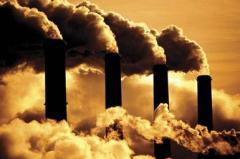The other day, Bill Laurance asked Barry Brook and me to comment on an opinion editorial he was doing up, so I feel fully justified in reproducing it here (and he asked me to ;-). It has just been published online in Australian Geographic.
–

I hate to be the bearer of bad news, but here it is: China is now the biggest global emitter of carbon dioxide (CO2), the chief greenhouse gas – and Australia has helped it attain that dubious honour.
China now spews out about 6.5 billion tons of CO2 annually, whereas the USA emits 5.8 billion tons a year (based on data for 2008 compiled by the U.S. Department of Energy). Collectively, these two countries account for over 40 per cent of global CO2 emissions. Number three on the list is Russia, with 1.7 billion tons per year, followed closely by India.
Of course, China’s huge leap in emissions is largely down to its dramatic industrial and economic growth, in concert with the fact that it is the world’s most populous nation, with over 1.3 billion people. To help fuel its growth, China is now building nearly one new coal-fired power-generating plant per week.
Export commodity
That’s bad news for the environment, because coal is the most carbon-dense of all fossil fuels, producing significantly more carbon dioxide than electricity generated from oil or gas. Emissions from renewable sources, such as hydroelectricity, nuclear, solar and wind are roughly a hundred times lower again.
And where does China get its coal? Much of it comes from Australia. Black coal is Australia’s biggest export commodity, accounting for 23 per cent of the country’s total exports. Over a 12-month period from 2008-2009, 25 million tonnes of Australian coal was shipped to China, representing almost a tenth of Australia’s coal exports. This will grow further as China struggles to meet its rapidly escalating energy demands.
And don’t be fooled for one second about phrases like ‘clean coal’. At present, there’s no such thing. Many modern coal-fired generating plants have scrubbers (technically called ‘electrostatic precipitators’) to help remove soot and sulphur dioxide in their emissions. But these scrubbers don’t do a thing to reduce CO2 emissions.
Trapping and storing CO2 is technically feasible but enormously expensive, both in terms of dollars and energy consumption. So far, not a single commercial coal-fired generating plant in the entire world is removing CO2 from its emissions. Another way to look at CO2 emissions – perhaps the fairest way – is on a per-capita basis. Again, things are surprisingly bad for Australia: it ranks worst in the world. On average, each Aussie produces 20.8 tonnes of CO2 per year.
Little excuse
That beats out the yearly per-capita emissions of other top polluters, including the USA (19.2 tonnes), Canada (17.3 tonnes) and Saudi Arabia (16.6 tonnes). And unlike the USA and Canada, Australia doesn’t have to content with frigid winters, which require large quantities of energy for heating (much of Saudi Arabia’s emissions come from large-scale petroleum production).
What does all this mean? For starters, it highlights the fact that Australia has much scope to increase its energy efficiency and reduce its CO2 emissions. A market-based carbon tax is probably the most effective way to achieve this.
This would put the onus on heavy industries such as steel manufacturing and coal-fired electricity generators (which supply 80 per cent of Australia’s energy) to cut their emissions, while promoting cleaner energy sources, industries and eco-friendly technologies.
In addition, it suggests Aussies shouldn’t be too holier-than-thou when criticising countries like the USA. There’s no doubt that Americans need to clean up their act – with just 2 per cent of the global population they’re gobbling up a quarter of all petroleum supplies. But as the world’s worst per-capita CO2 polluter and as one of the leading global exporters of dirty coal, Australia should be sitting in the sin bin right beside them.
WF Laurance, James Cook University

